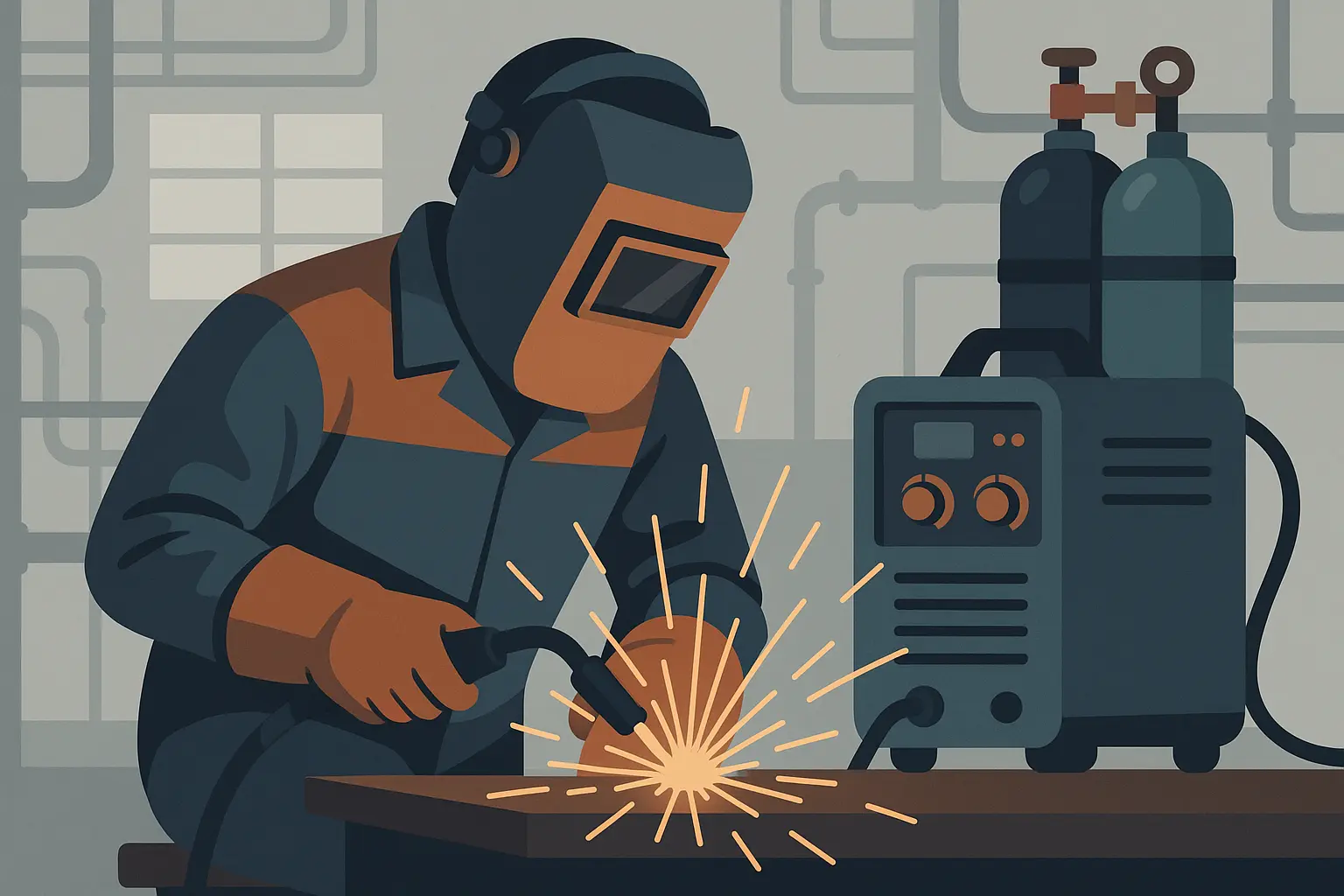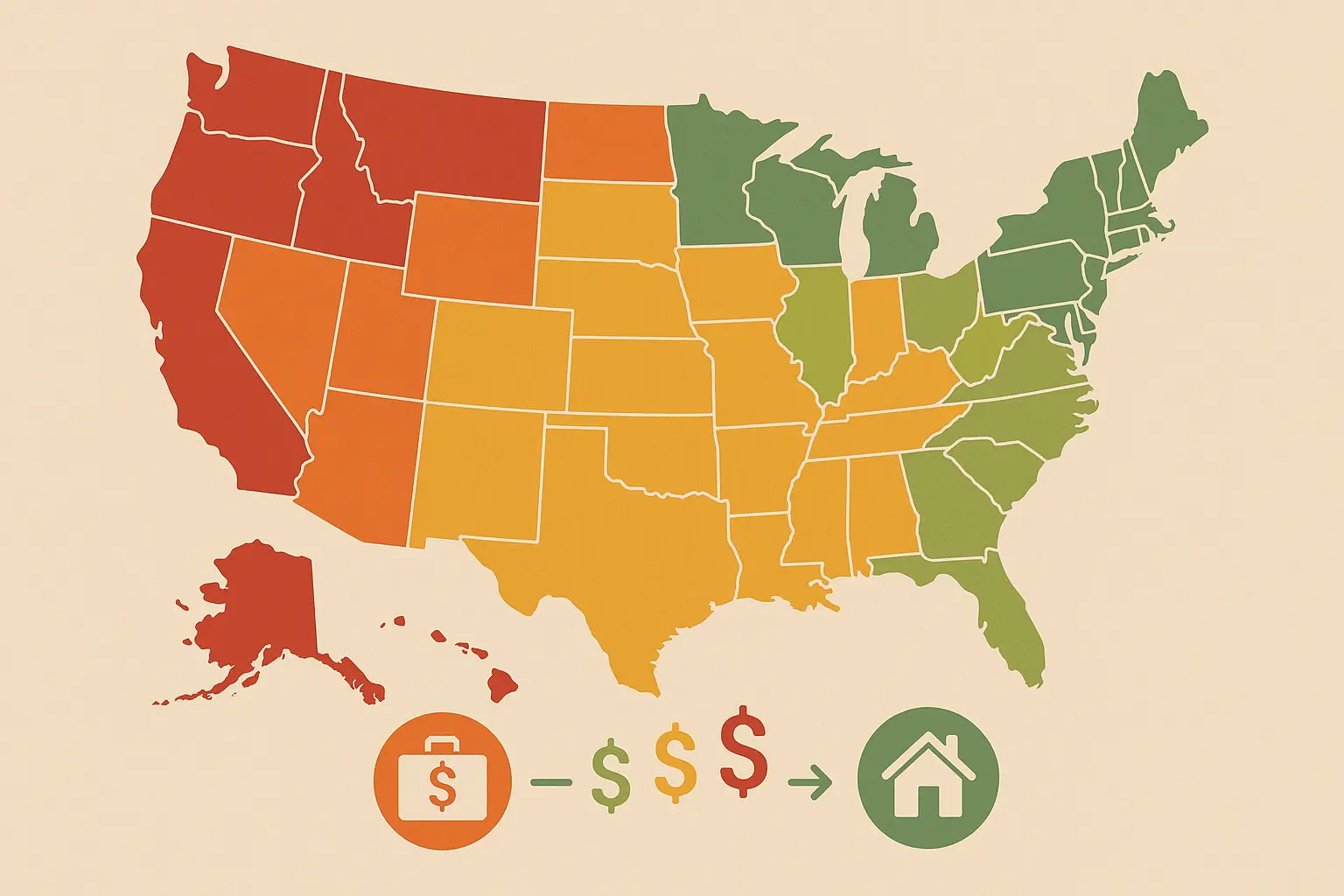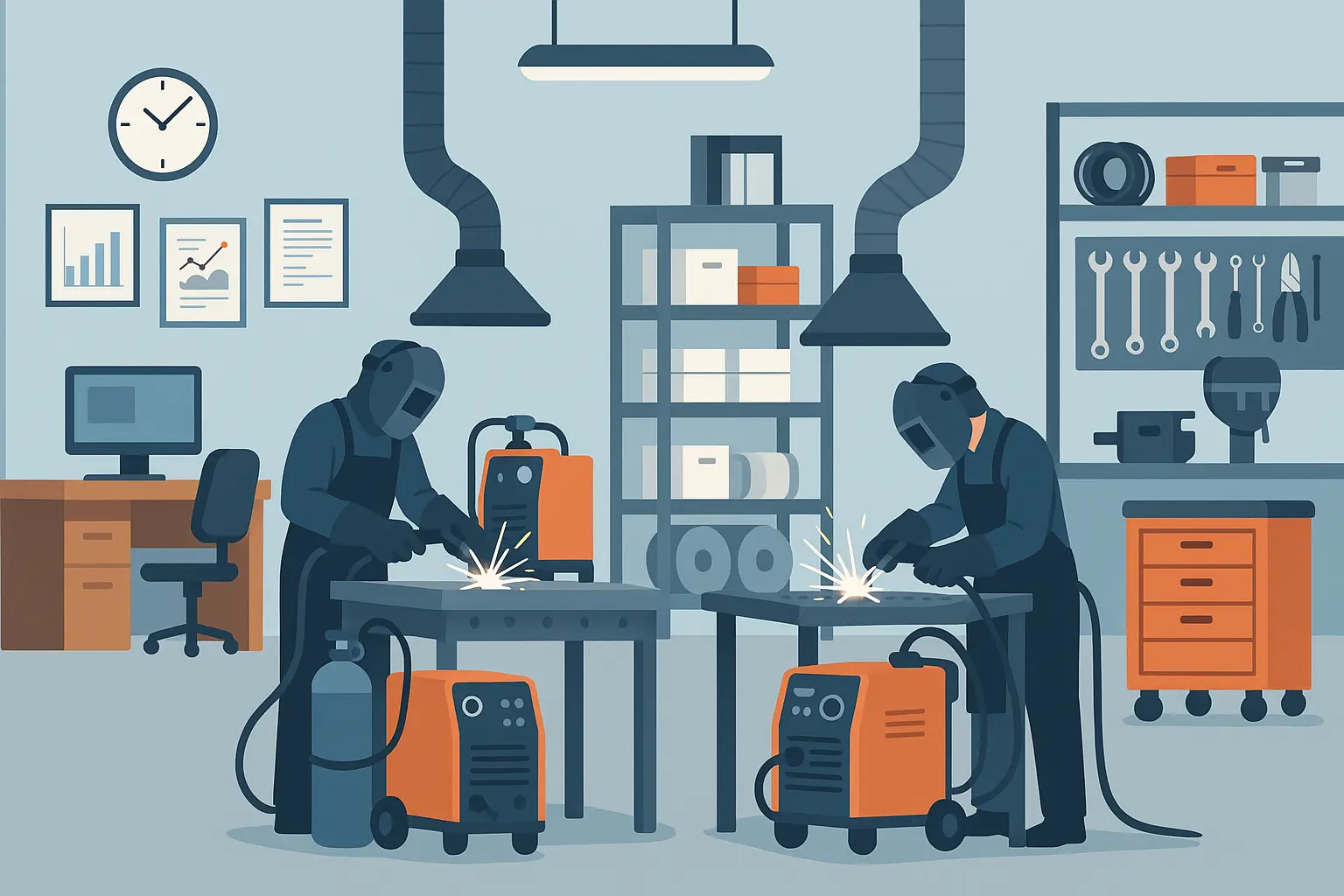Look, I get it – trying to figure out what welders actually make is frustrating as hell. You see those generic salary surveys saying median salaries of $51,000 or averages at $43,714, but that’s like saying all cars cost $30,000. It’s technically a number, but it tells you nothing useful.
Here’s what those surveys don’t tell you: I know welders making $35k who are drowning in bills, and others pulling $85k who started at the same shop three years ago. The difference? They figured out the game.
The welding profession offers massive earning potential that goes way beyond those basic statistics. I’ve seen welders jump from $35,000 to $85,000 in just a few years by making smart moves with certifications, location choices, and industry specialization. The key is understanding how to position yourself strategically instead of just hoping for the best.
Table of Contents
-
The Real Numbers Behind Welder Paychecks
-
Why Your Location Could Make or Break Your Wallet
-
Smart Moves That Actually Boost Your Welding Income
-
What’s Coming Next for Welding Careers
TL;DR
-
Entry-level welders start around $35,000-$42,000, but experienced pros can hit $65,000+ with the right moves
-
California welders make $52,000-$68,000 annually, while states like Ohio offer better cost-of-living ratios
-
AWS certifications typically add $3,000-$8,000 to your yearly pay – they’re worth the investment
-
Energy sector welders earn $55,000-$85,000, with offshore positions reaching six figures
-
Independent contractors can charge $50-$100+ per hour, but income varies significantly
-
Robotic welding programming skills command $60,000-$80,000 salaries in today’s market
The Real Numbers Behind Welder Paychecks
Most welders wonder if they’re getting paid what they’re worth, and honestly, the welder salary ranges are much wider than people realize. I’ve spent years tracking these numbers, and the earning potential in welding is incredible – if you know where to look.
From entry-level positions starting around $35,000 to specialized roles hitting six figures, your earning potential depends heavily on your skills, certifications, and industry choice. The question isn’t how much do welders make in general – it’s how much YOU can make with the right strategy.
What You’ll Actually Make Starting Out vs. Years Down the Road
Starting salaries might surprise you – both ways. New welders typically earn between $35,000-$42,000 annually, which breaks down to roughly $16-$20 per hour. I know that might feel low compared to what you’ve heard about welding being a “high-paying trade,” but here’s the thing – this is just your starting point.
How much does a welder make after gaining experience? Everything changes once you’ve got some years under your belt. After five years in the field, skilled welders commonly earn $45,000-$65,000, with specialized certifications pushing that toward $70,000. The real money comes when you reach master-level expertise in specialized applications.
According to Bureau of Labor Statistics data, the hourly wage range for welders spans from $17.71 to $20.56, which aligns with entry-level expectations but represents just the beginning of earning potential. The average salary for welders jumps dramatically as you add skills and certifications to your toolkit.
|
Experience Level |
Annual Salary Range |
Hourly Rate |
Key Requirements |
|---|---|---|---|
|
Entry-Level (0-2 years) |
$35,000-$42,000 |
$16-$20 |
Basic certification, safety training |
|
Mid-Level (3-5 years) |
$45,000-$65,000 |
$22-$31 |
AWS certifications, specialized skills |
|
Expert (5+ years) |
$70,000-$120,000+ |
$34-$58+ |
Advanced certifications, specialization |
Breaking Down Entry-Level Reality
Fresh out of welding school, you’re looking at $35,000-$42,000 annually in most markets. Your hourly rate will likely fall between $16-$20, depending on your initial certifications and local demand.
The good news? Welding offers faster salary progression than many other trades if you’re strategic about skill development. I’ve watched welders who started at $18/hour jump to $28/hour within three years by focusing on the right certifications and job opportunities.
The Sweet Spot: Experienced Professional Territory
Once you’ve got 5+ years under your belt, everything changes. Experienced welders typically command $45,000-$65,000 annually, and this is where specialized certifications really start paying off.
I’ve seen welders jump from $45,000 to $70,000 just by adding the right certifications to their toolkit. Take Sarah, a structural welder in Texas who started at $38,000 in 2019. After earning her AWS D1.1 structural certification and adding TIG welding skills, she moved to a pipeline company in 2022 earning $62,000 annually. By 2024, with additional pipe welding certification, she’s now making $74,000 plus overtime opportunities.
The key is choosing certifications that align with high-demand industries in your area. Random certifications won’t help – strategic ones will transform your earning potential.
Master-Level Money: Where the Big Bucks Live
Expert welders in specialized fields represent the profession’s earning ceiling. Underwater welders, aerospace specialists, and nuclear facility welders can earn $80,000-$120,000+ annually.
These positions require extensive training and often involve challenging working conditions, but the compensation reflects the specialized expertise required. Getting here takes years of dedicated skill development, but the financial rewards are substantial. We’re talking about welders who’ve become true specialists in their field.
Industry Sectors: Where the Money Really Is
Industry choice significantly impacts your welder salary potential. Construction and infrastructure welding typically offers $40,000-$55,000 annually, with union positions including comprehensive benefits that increase total compensation value.
Manufacturing welders usually earn $38,000-$52,000, with automotive and heavy machinery sectors on the higher end. The real money is in energy sector positions, where oil, gas, and renewable energy welders command $55,000-$85,000 annually, with offshore and hazardous duty positions reaching six-figure compensation.
Manufacturing industry welders earn an average of $39,520 per year, while union welders command significantly higher wages at $74,896 annually, demonstrating the substantial impact of industry choice and union membership on earning potential.
Construction: Steady Work, Union Benefits
Construction welders average $40,000-$55,000 annually, but don’t overlook the value of union positions. Union jobs often include comprehensive benefits packages – health insurance, retirement contributions, and paid time off – that significantly increase your total compensation value.
The work is steady, and there’s always demand for skilled construction welders. Plus, you get the satisfaction of seeing your work become part of the skyline or infrastructure that people use every day.
Manufacturing: Consistent Hours, Predictable Pay
Manufacturing welders typically earn $38,000-$52,000 annually, with automotive and heavy machinery sectors offering higher-end salaries within this range. The appeal here is consistency – regular hours, predictable schedules, and stable employment.
While the pay might not be the highest, the work-life balance often makes up for it. You know when you’re working, when you’re off, and you can plan your life accordingly.
Energy Sector: Where Welders Strike Gold
Energy sector welding is where you’ll find the highest-paying opportunities. Oil, gas, and renewable energy welders command $55,000-$85,000 annually, with offshore and hazardous duty positions reaching six-figure compensation levels.
The work can be demanding and sometimes dangerous, but the financial rewards reflect these challenges. The welding industry is actively working to expand opportunities for underrepresented groups. A Phoenix nonprofit welding school is helping women with challenging backgrounds learn welding skills, with instructors noting that “entry-level welder’s salary can be around $20 an hour”, providing these students with real pathways to financial independence and career stability.
Why Your Location Could Make or Break Your Wallet
Geography plays a massive role in welder earnings – sometimes more than skill level. Welder salary by state variations can be shocking when you dig into the numbers.
California pays more, but your rent will eat you alive. Alaska pays great, but good luck finding decent pizza. Want my honest take? Look at Ohio, Texas, or North Carolina. You’ll make decent money ($42k-$55k), your mortgage won’t require selling a kidney, and you can actually have a life outside work.
The question isn’t just how much does a welder make in California – it’s whether that higher salary actually puts more money in your pocket after expenses.
The Highest-Paying States (And What It Really Costs to Live There)
California, Alaska, and Hawaii top the charts for welder salaries, but the full picture is more complex. Welder salary in California averages $52,000-$68,000 annually, with Bay Area and Los Angeles metropolitan regions commanding premium wages up to $75,000 for experienced professionals.
Alaska welders earn $55,000-$85,000 annually due to remote work conditions and infrastructure demands, while Hawaii offers $48,000-$62,000 with unique island project premiums. However, these higher salaries often come with significantly higher living costs.
In Los Angeles specifically, a Level 3 Welder with 5.5 years of experience can earn $76,500 annually, though this salary must be weighed against the city’s high cost of living where “average rental prices in Los Angeles are significantly higher than many other cities in the U.S.”
California: High Pay, Higher Costs
California welders average $52,000-$68,000 annually, with the Bay Area and Los Angeles pushing experienced professionals toward $75,000. The state’s massive construction projects, aerospace industry, and manufacturing base create strong demand for skilled welders.
However, housing costs and general living expenses can consume much of that higher salary, especially in major metropolitan areas. Consider Mike, a certified welder earning $68,000 in San Francisco versus his counterpart Tom making $48,000 in Columbus, Ohio. After accounting for housing costs ($3,200/month vs $1,200/month), taxes, and living expenses, Tom actually has more disposable income despite earning $20,000 less annually.
The Smart Money States: Where Your Dollar Goes Further
Smart welders look beyond just salary numbers to find the best overall value. The average salary for welder positions in Midwest states like Ohio, Indiana, and Michigan ranges from $42,000-$55,000 with significantly lower living costs, often providing superior quality of life ratios.
Southern states like Texas, Louisiana, and North Carolina combine moderate living costs with growing industrial sectors, offering $40,000-$58,000 salaries with strong job security. Northeast industrial corridors provide $45,000-$65,000 welder salaries, with union representation often securing comprehensive benefit packages.
|
State Category |
Salary Range |
Cost of Living |
Quality of Life Index |
Best For |
|---|---|---|---|---|
|
High-Pay Coastal |
$52,000-$75,000 |
High |
Moderate |
Career advancement, industry diversity |
|
Midwest Value |
$42,000-$55,000 |
Low-Moderate |
High |
Work-life balance, homeownership |
|
Growing South |
$40,000-$58,000 |
Moderate |
High |
Job security, industry growth |
|
Northeast Union |
$45,000-$65,000 |
Moderate-High |
Moderate |
Benefits, job protection |
Midwest Value: More Bang for Your Buck
States like Ohio, Indiana, and Michigan offer $42,000-$55,000 welder salaries with significantly lower living costs. Your housing dollar goes much further here, and you’ll find strong manufacturing bases that provide steady employment.
The quality of life ratio is often superior to higher-paying coastal areas when you factor in housing costs, commute times, and general cost of living. You might not make California money, but you’ll probably live better on what you earn.
Southern Opportunities: Growth Markets with Reasonable Costs
Texas, Louisiana, and North Carolina combine moderate living costs with growing industrial sectors. Welders in these states typically earn $40,000-$58,000 with strong job security due to expanding energy, manufacturing, and infrastructure sectors.
The cost of living remains reasonable, and many of these areas are experiencing significant economic growth that creates new opportunities for skilled welders.
Smart Moves That Actually Boost Your Welding Income
Here’s the truth nobody wants to tell you: most welders stay broke because they think showing up and doing good work is enough. It’s not.
I’ve watched guys with amazing skills plateau at $45k while mediocre welders with the right certifications cruise past $70k. The difference? Strategy.
Stop Collecting Random Certifications
Every welder thinks more certificates = more money. Wrong. I know a guy with seven AWS certifications making $48k, while his buddy with just two targeted ones makes $68k.
Here’s how to do it right: Look at job postings in your area for the next three months. What certifications keep showing up? Those are your targets. Ignore everything else.
In Texas? Pipe welding certification will get you hired tomorrow at $28-35/hour. In California? Structural welding opens doors to $75k+ jobs. In the Midwest? TIG certification for manufacturing work is your golden ticket.
American Welding Society (AWS) certifications typically add $3,000-$8,000 to annual salaries, with structural welding certifications being particularly valued by employers. Specialized process certifications each command specific premiums, with pipe welding often providing the highest immediate salary boost.
When pursuing advanced certifications, having proper documentation is crucial. If you’ve lost or damaged your original welding school certificates, getting a replacement diploma ensures you have backup credentials for career advancement opportunities.
The Real Certification Strategy
Here’s what actually works:
-
Spend a weekend researching local job demands
-
Pick ONE high-value certification
-
Get it, then immediately start applying for better jobs
-
Use that raise to fund your next certification
-
Repeat until you’re where you want to be
Take my friend Jake who wasted $3,000 on random AWS certs that nobody in our area cared about. Meanwhile, his coworker Maria spent $800 on pipe welding certification and immediately jumped from $22/hour to $31/hour because every contractor in town needed pipe welders.
Moving Up Without Moving Out
You don’t have to leave your current job to make more money. Sometimes the best opportunity is right where you are.
Take my friend Carlos. He was making $42k as a shop welder, getting frustrated watching newer guys get promoted. Instead of quitting, he asked his supervisor what it would take to move up. Turns out they needed someone to train new hires and handle quality control.
Carlos spent six months learning those skills on his own time. When the supervisor position opened up, he was the obvious choice. Now he makes $61k managing the same guys he used to work beside.
Welding supervisors and foremen earn $55,000-$75,000 annually, but getting there requires more than just welding skills. You’ll need to develop management capabilities, understand project planning, and learn to work with diverse teams.
The Internal Advancement Playbook
Here’s what actually works:
-
Ask your boss what skills they need most
-
Volunteer for projects nobody else wants
-
Learn basic management and safety protocols
-
Document everything you do (seriously, keep records)
-
When promotion time comes, you’ll have proof you’re ready
Going Solo: The Reality Check
Everyone talks about independent contracting like it’s easy money. “$100/hour!” they say. What they don’t mention is the months with zero income, the clients who don’t pay, and the equipment that breaks at the worst possible time.
I’ve seen contractors make $150k one year and $32k the next. The successful ones treat it like a business, not just welding with extra steps.
Independent contracting and business ownership represent the highest earning potential for experienced welders, but they come with significant risks and responsibilities. The average salary for a welder working independently can vary dramatically – skilled contractors can earn $50-$100+ per hour on specialized projects.
If you’re thinking about going independent, here’s my advice: Don’t quit your day job yet. Start taking small side jobs on weekends. Build a client base. Save money. When your side work consistently makes more than your regular job for six months straight, then consider the jump.
Before You Go Independent
-
Have at least six months of expenses saved
-
Line up three reliable clients before you quit
-
Get proper insurance (it’s not optional)
-
Learn to say no to bad clients early
-
Track every expense for taxes
Business Ownership: The Ultimate Earning Potential
Successful welding shop owners often achieve six-figure annual incomes, representing the profession’s highest earning potential. However, this path requires business acumen beyond technical welding skills – you’ll need to understand marketing, finance, employee management, and business operations.
The risks are substantial, but so are the potential rewards for those who can successfully build and manage a welding business. You’re not just selling your welding skills anymore – you’re building a company.
What’s Actually Coming Next
Let me cut through the hype about robots taking welding jobs. It’s not happening the way people think.
Yes, robots are doing more basic welding. But someone has to program them, maintain them, and handle the complex stuff they can’t do. That someone can be you, if you’re smart about it.
The Robot Programming Opportunity
Robotic welding technicians make $60-80k because they combine old-school welding knowledge with new tech skills. It’s not as hard as it sounds – most of the programming is visual, like advanced video game controls.
I know a welder who took a six-month robotics course at his community college while working full-time. Now he programs and maintains welding robots for an automotive supplier. His salary jumped from $47k to $72k, and he works in air conditioning instead of sweltering shop floors.
Welders skilled in robotic programming and maintenance command premium salaries of $60,000-$80,000, representing the growing intersection of traditional welding skills and modern technology. This field requires understanding both welding fundamentals and programming concepts.
Advanced Materials: Specialized Knowledge, Premium Pay
Expertise in titanium, composites, and exotic alloys creates niche markets with premium pricing. Welders specializing in these advanced materials often earn 20-40% above standard welding rates because the work requires specialized knowledge and precision.
As industries like aerospace, medical devices, and high-performance automotive continue growing, demand for these specialized skills increases. These aren’t skills you pick up overnight, but the investment in learning them pays substantial dividends.
Green Energy Isn’t Just Hype
Wind turbine and solar installation work is real, and it pays well. These aren’t temporary government programs – they’re permanent shifts in how we make energy.
Wind turbine welders make $50-65k and travel constantly, which some love and others hate. Solar installation welders make similar money with less travel but more roof work. Both beat typical manufacturing wages and have better job security.
Government infrastructure spending and renewable energy expansion are creating sustained demand for skilled welders. Wind turbine and solar panel installation welders earn $45,000-$65,000 annually, with rapid sector growth providing excellent job security and advancement opportunities.
The work can be physically demanding and weather-dependent, but if you don’t mind heights and outdoor conditions, it’s solid money in a growing field.
The Bottom Line
Your welding salary isn’t determined by some cosmic force or industry conspiracy. It’s determined by the choices you make about skills, location, and opportunities.
The welders making real money aren’t necessarily the most talented. They’re the ones who figured out what employers actually need and positioned themselves to provide it.
Stop waiting for someone to recognize your skills and start making strategic moves. Research your local job market. Get the certifications that matter in your area. Apply for better jobs. Ask for raises. Consider relocating if it makes financial sense.
Most importantly, treat your welding career like a business. Track your income, invest in profitable skills, and always be looking for the next opportunity to increase your value.
Welding offers genuine opportunities for financial success, but it requires strategic thinking beyond just learning to lay a good bead. The difference between welders earning $35,000 and those pulling in $80,000+ isn’t just experience – it’s making smart choices about certifications, location, and career progression.
Your earning potential in welding isn’t fixed by some industry standard. It’s determined by how well you understand the market, how strategically you build your skills, and how willing you are to pursue opportunities that others might overlook. Whether that means relocating to a higher-paying state, investing in specialized certifications, or eventually starting your own business, the path to higher earnings is there for welders who are willing to plan and execute.
The welding industry is changing, but that creates opportunities rather than just challenges. Technology integration, infrastructure investment, and green energy expansion are creating new high-paying niches for welders who position themselves correctly. The key is staying informed about these trends and developing the skills that will be in demand tomorrow.
The difference between welders making $35k and $80k isn’t talent – it’s strategy. Now you know the strategy. The question is: what are you going to do with it?










